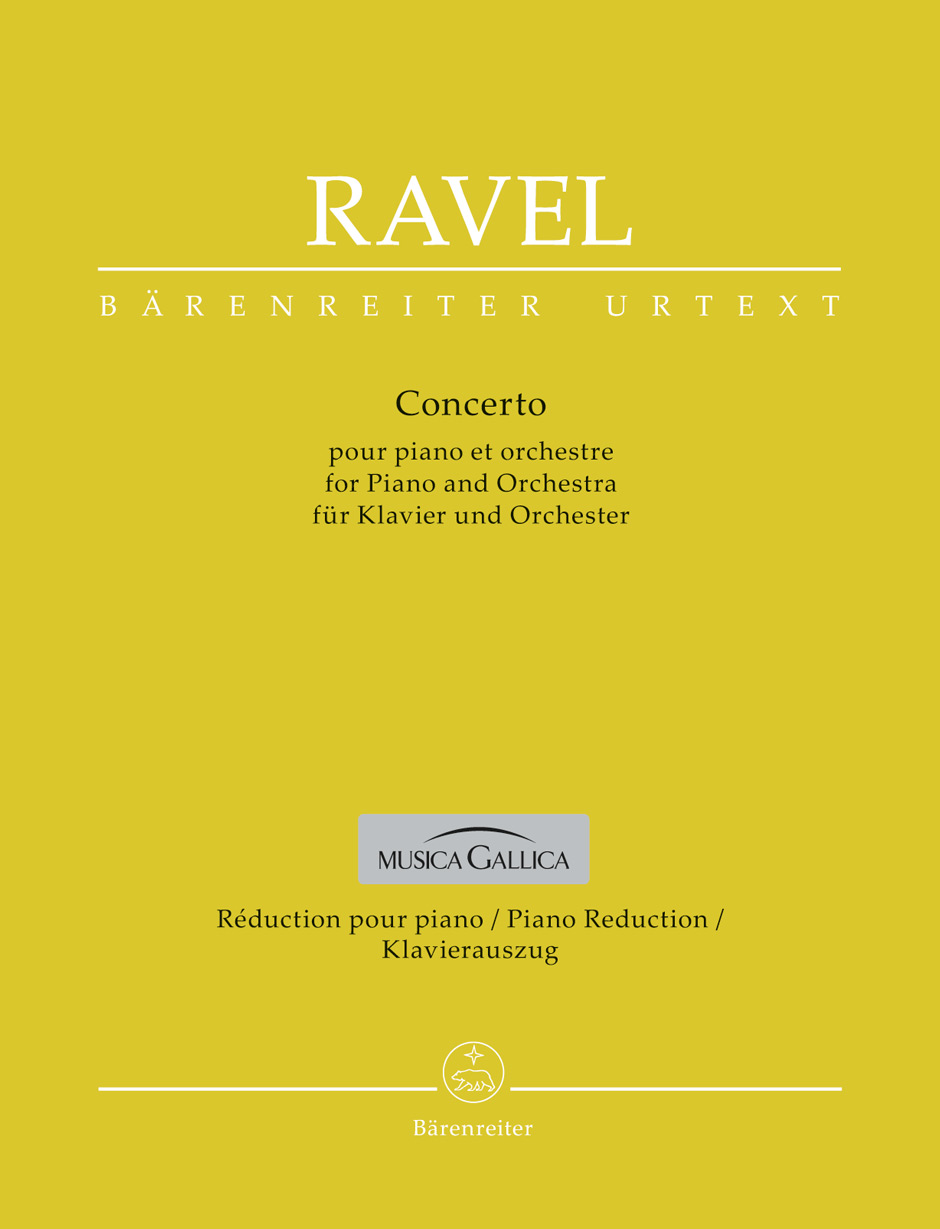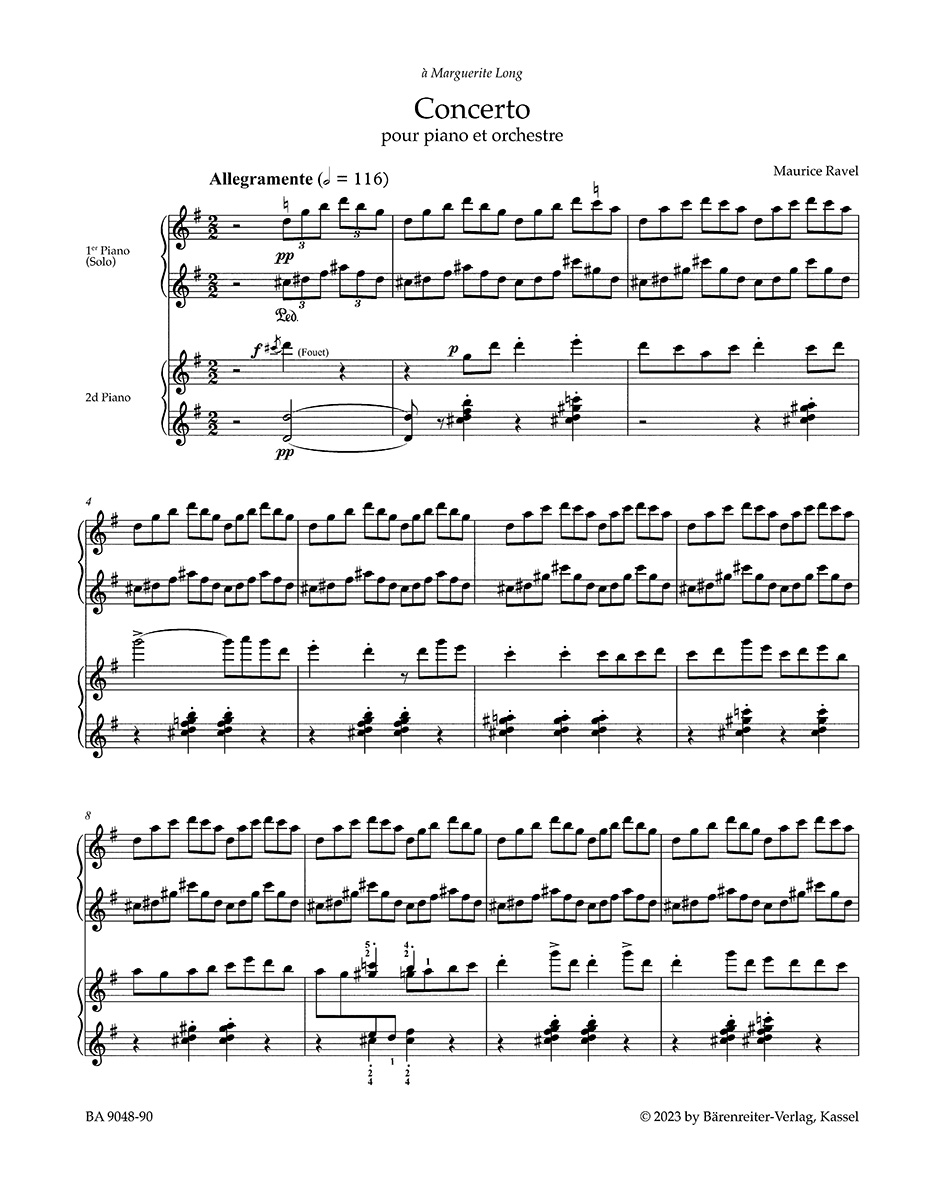
Happy Present Meet

Ravel Piano Concerto in G Major for 2 Pianos 4 Hands
Concerto for Piano and Orchestra (Piano Reduction)
- Restoring of the original musical text authorised by Ravel
- Retaining the idiosyncracies of Ravel’s notation (e.g. allocation of treble and bass clef)
- Appendix with a list of alternative readings
In the 1960s, long after Ravel’s death, the musical text of the then available Durand edition of Ravel’s Piano Concerto in G major underwent various changes. Although it is unknown who authorised these changes, they have become established as common performance practice.
A variety of sources were consulted for this new edition. The first print of the score, parts and piano reduction as well as a set of proofs used by pianist Marguerite Long to rehearse the work for the premiere served as the main sources. Ravel’s autograph, which was used as the engraver’s copy for the first print, must be considered a secondary source as Ravel later authorised changes during the proofreading process. Additionally, a set of handwritten orchestral parts owned by André Kostelanetz, the first sound recording of the concerto as well as copies of the first print of the piano reduction which Marguerite Long, Alfred Cortot, Gustave Samazeuilh, and Robert Casadesus received as gifts were consulted as secondary sources. These piano reductions, all from the possession of musicians who belonged to Ravel’s closest circle, have played a major role in restoring the original form of the work as it was published and performed under Ravel’s supervision.
The musical text appears in a clear, spacious layout with optimum page turns. Characteristics of Ravel’s notation have been retained with regard to cautionary accidentals, beaming, stemming and the distribution of the piano part between the upper and lower staves. The piano reduction offers an innovative solution to the problem that not all the layers of the orchestral writing can be reproduced in the piano part: for some passages two versions are presented, one with a reduction of the wind parts and one with a reduction of the string parts.
The text apparatus contains notes on interpretation, e.g., with regard to tempo based on the 1932 recording with Marguerite Long as soloist which was carried out in the presence of Ravel.
피아노와 오케스트라를 위한 협주곡 (피아노 축소판)
- 라벨이 승인한 원본 악보 복원
- 라벨 표기법의 특징 유지(예: 높은음자리표와 낮은음자리표 배치)
- 대체 악보 목록 부록
라벨이 사망한 지 오랜 후인 1960년대에 당시 사용 가능했던 라벨의 피아노 협주곡 G장조 뒤랑 판의 악보는 여러 가지 수정을 거쳤습니다. 누가 이러한 수정을 승인했는지는 알 수 없지만, 이는 일반적인 연주 관행으로 자리 잡았습니다.
이 새로운 판본을 위해 다양한 자료를 참고했습니다. 악보, 파트, 피아노 축소판의 초판본과 피아니스트 마르그리트 롱이 초연을 위해 연습했던 교정본 세트가 주요 자료로 사용되었습니다. 초판본의 판화 제작자 사본으로 사용된 라벨의 친필 사인본은 라벨이 나중에 교정 과정에서 수정을 승인했기 때문에 2차 자료로 간주해야 합니다. 또한, 앙드레 코스텔라네츠가 소장한 손으로 쓴 오케스트라 파트 세트, 협주곡의 최초 음원, 그리고 마르그리트 롱, 알프레드 코르토, 귀스타브 사마즈이, 로베르 카사드쉬가 기증받은 피아노 리덕션의 첫 번째 인쇄물 사본이 2차 자료로 참고되었습니다. 라벨의 가장 가까운 동료들이 소장했던 이 피아노 리덕션들은 라벨의 감독 하에 출판되고 연주되었던 당시의 작품 원형을 복원하는 데 중요한 역할을 했습니다.
악보는 최적의 페이지 넘김을 통해 명확하고 넓은 레이아웃으로 표현됩니다. 주의적인 임시표, 비밍, 스테밍, 그리고 피아노 파트를 위아래 보표 사이에 배치하는 방식 등 라벨 표기법의 특징이 그대로 유지되었습니다. 피아노 리덕션은 오케스트라 악보의 모든 층을 피아노 파트로 재현할 수 없다는 문제에 대한 혁신적인 해결책을 제시합니다. 일부 악절은 관악기 파트를 리덕션한 버전과 현악기 파트를 리덕션한 버전, 두 가지 버전으로 제공됩니다.
본 텍스트 장치에는 해석에 대한 주석이 포함되어 있습니다. 예를 들어, 1932년 라벨의 연주 하에 마르그리트 롱이 독주자로 참여한 녹음을 바탕으로 템포와 관련된 주석이 포함되어 있습니다.
Duration (approx.): 00:22:00
Contents
· Composer / Author: Woodfull-Harris, Douglas
Introduction (English)
· Composer / Author: Woodfull-Harris, Douglas
Introduction (français)
· Composer / Author: Woodfull-Harris, Douglas
Einleitung
· I Allegramente
· II Adagio assai
· III Presto
작곡가 Ravel, Maurice(1875-1937)
에디터 Woodfull-Harris, Douglas
